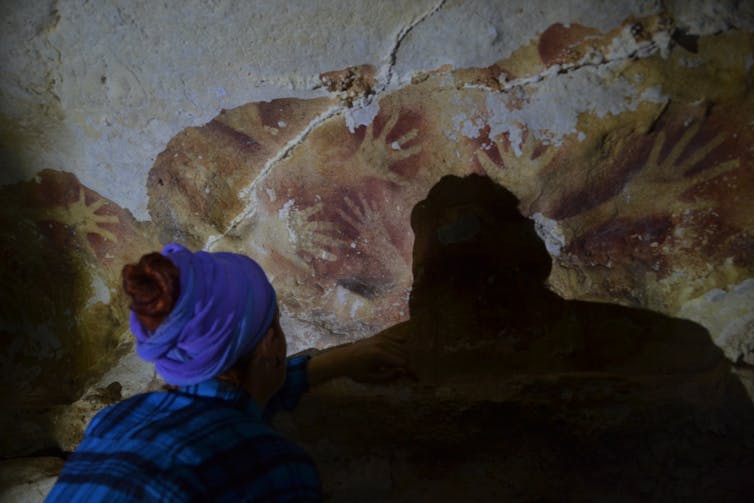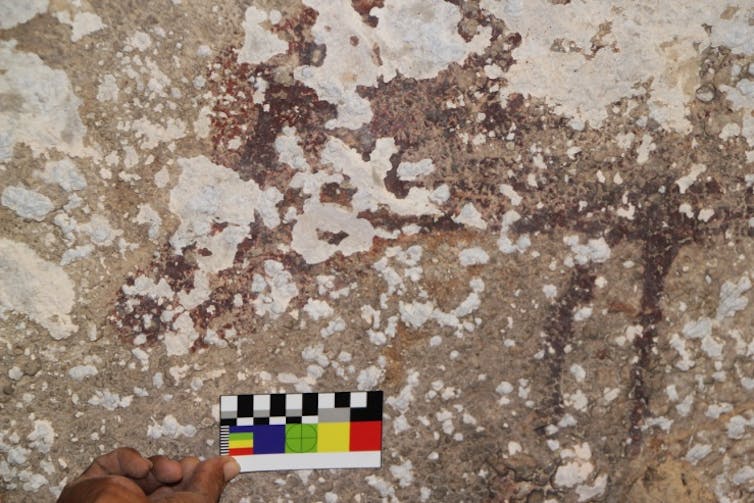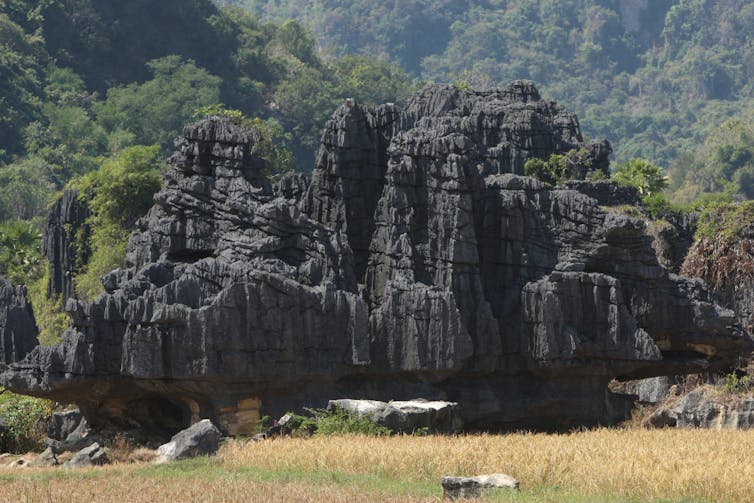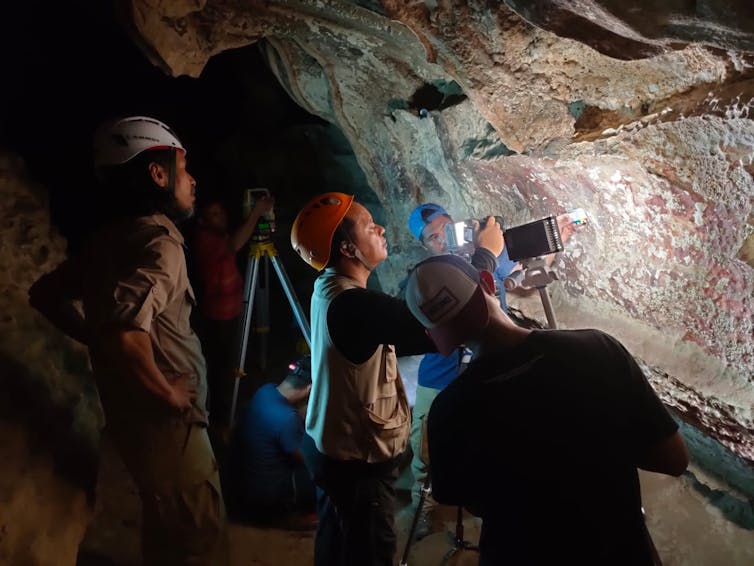How climate change is erasing the world’s oldest rock art
- Written by Jillian Huntley, Research Fellow, Griffith University
In caves on the Indonesian island of Sulawesi, ancient peoples marked the walls with red and mulberry hand stencils, and painted images of large native mammals or imaginary human-animal creatures.
These are the oldest cave art sites yet known — or at least the oldest attributed to our species. One painting of a Sulawesi warty pig was recently dated as at least 45,500 years old.
Since the 1950s, archaeologists have observed these paintings appear to be blistering and peeling off the cave walls. Yet, little had been done to understand why.
So our research, published today, explored the mechanisms of decay affecting ancient rock art panels at 11 sites in Sulawesi’s Maros-Pangkep region. We found the deterioration may have gotten worse in recent decades, a trend likely to continue with accelerating climate change.
These Pleistocene (“ice aged”) cave paintings of Indonesia have only begun to tell us about the lives of the earliest people who lived in Australasia. The art is disappearing just as we’re beginning to understand its significance.
Australasia’s rock art
Rock art gives us a glimpse into the ancient cultural worlds of the artists and the animals they may have hunted or interacted with. Even rare clues into early people’s beliefs in the supernatural have been preserved.
Climate change could erase ancient Indonesian cave art.We think humans have been creating art of some kind in Australasia — which includes northern Australia, Papua New Guinea and Indonesia — for a very long time. Used pigments are among the earliest evidence people were living in Australia more than 60,000 years ago.
Read more: Buried tools and pigments tell a new history of humans in Australia for 65,000 years
Tens of thousands of distinctive rock art sites are scattered across Australasia, with Aboriginal people creating many styles of rock art across Australia.
Until as recently as 2014, scholars thought the earliest cave art was in Europe — for example, in the Chauvet Cave in France or El Castillo in Spain, which are 30,000 to 40,000 years old. We now know people were painting inside caves and rockshelters in Indonesia at the same time and even earlier.
 Hand stencils in one of the study sites at Leang Sakapao cave.
Linda Siagian, Author provided
Hand stencils in one of the study sites at Leang Sakapao cave.
Linda Siagian, Author provided
Ongoing surveys throughout Australasia turn up new rock art sites every year. To date, more than 300 painted sites have been documented in the limestone karsts of Maros-Pangkep, in southern Sulawesi.
Cave paintings in Sulawesi and Borneo are some of the earliest evidence we have that people were living on these islands.
Tragically, at almost every new site we find in this region, the rock art is in an advanced stage of decay.
Big impacts from small crystals
To investigate why these prehistoric artworks are deteriorating, we studied some of the oldest known rock art from the Maros-Pangkep region, scientifically dated to between at least 20,000 and 40,000 years old.
 Expanding and contracting salt crystals are causing rock art to flake off the cave walls.
Linda Siagian, Author provided
Expanding and contracting salt crystals are causing rock art to flake off the cave walls.
Linda Siagian, Author provided
Given these artworks have survived over such a vast period, we wanted to understand why the painted limestone cave surfaces now appear to be eroding so rapidly.
We used a combination of scientific techniques, including using high-powered microscopes, chemical analyses and crystal identification to tackle the problem. This revealed that salts growing both on top of and behind ancient rock art can cause it to flake away.
Read more: Indonesian cave paintings show the dawn of imaginative art and human spiritual belief
Salts are deposited on rock surfaces via the water they’re absorbed in. When the water solution evaporates, salt crystals form. The salt crystals then swell and shrink as the environment heats and cools, generating stress in the rock.
In some cases, the result is the stone surface crumbling into a powder. In other instances, salt crystals form columns under the hard outer shell of the old limestone, lifting the art panel and separating it from the rest of the rock, obliterating the art.
On hot days, geological salts can grow to more than three times their initial size. On one panel, for example, a flake half the size of a hand peeled off in under five months.
Climate extremes under global warming
Australasia has an incredibly active atmosphere, fed by intense sea currents, seasonal trade winds and a reservoir of warm ocean water. Yet, some of its rock art has so far managed to survive tens of thousands of years through major episodes of climate variation, from the cold of the last ice age to the start of the current monsoon.
 Limestone karsts of Maros and Pangkep Regencies, in South Sulawesi, Indonesia.
Shutterstock
Limestone karsts of Maros and Pangkep Regencies, in South Sulawesi, Indonesia.
Shutterstock
In contrast, famous European cave art sites such as Altamira in Spain and Lascaux in France are found in deep caves, in more stable (temperate) climates, so threats to rock art are different and generally weathering is less aggressive.
But now greenhouse gases are magnifying climatic extremes. In fact, global warming can be up to three times higher in the tropics, and the wet-dry phases of the monsoon have become stronger in recent decades, along with more numerous La Niña and El Niño events.
Read more: Climate explained: will the tropics eventually become uninhabitable?
The net effect is that temperatures are higher, there are more hot days in a row, droughts are lasting longer, and other extreme weather such as storms (and the flooding they cause) are more severe and frequent.
What’s more, monsoonal rains are now captured in rice fields and aquaculture ponds. This promotes the growth of art-destroying salt crystals by raising humidity across the region and especially in nearby caves, prolonging the shrink and swell cycles of salts.
 Makassar’s culture heritage department, Balai Pelestarian Cagar Budaya, undertaking rock art monitoring in Maros-Pangkep.
Rustan Lebe/Griffith University, Author provided
Makassar’s culture heritage department, Balai Pelestarian Cagar Budaya, undertaking rock art monitoring in Maros-Pangkep.
Rustan Lebe/Griffith University, Author provided
What happens now?
Apart from the direct threats associated with industrial development — such as blasting away archaeological sites for mining and limestone quarrying — our research makes it clear global warming is the biggest threat to the preservation of the trpoics’ ancient rock art.
There’s a pressing need for further research, monitoring and conservation work in Maros-Pangkep and across Australasia, where cultural heritage sites are under threat from the destructive impacts of climate change.
Read more: Rio Tinto just blasted away an ancient Aboriginal site. Here’s why that was allowed
In particular, we urgently need to document the remaining rock art in great detail (such as with 3D scanning) and uncover more sites before this art disappears forever.
If humans are ultimately causing this problem, we can take steps to correct it. Most importantly, we need to act now to stop global temperature increases and drastically cut emissions. Minimising the impacts of climate change will help preserve the incredible artworks Australasia’s earliest people left to us.
Read more: Indonesian cave paintings show the dawn of imaginative art and human spiritual belief
Authors: Jillian Huntley, Research Fellow, Griffith University
Read more https://theconversation.com/how-climate-change-is-erasing-the-worlds-oldest-rock-art-159929





